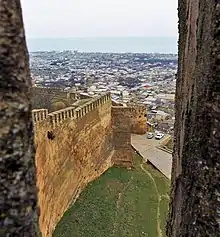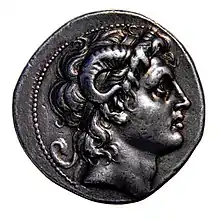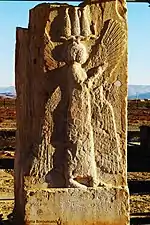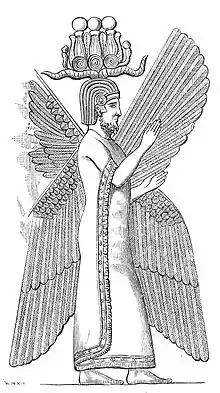Dhu al-Qarnayn
Dhu al-Qarnayn, (Arabic: ذُو ٱلْقَرْنَيْن Ḏū al-Qarnayn, IPA: [ðuː‿l.qar.najn]), Lit.: "He of the Two Horns"), also spelled Zu al-Qarnayn, appears in the Quran, Surah Al-Kahf (18), Ayahs 83-101 as one who travels to east and west and erects a wall between mankind and Gog and Magog (called Ya'juj and Ma'juj).[1] Elsewhere the Quran tells how the end of the world would be signaled by the release of Gog and Magog from behind the wall, and other apocalyptic writings report their destruction by God in a single night would usher in the Day of Resurrection (Yawm al-Qiyāmah).[2]

Early Muslim commentators and historians assimilated Dhu al-Qarnayn to several figures, among them Alexander the Great, the Parthian king Kisrounis,[3] the South-Arabian Himyarite king Sa'b Dhu Marathid, and the North-Arabian Lakhmid king al-Mundhir ibn Imru al-Qays.[4] Some have argued that the origins of the Quranic story lies in the Syriac Alexander Legend,[5] but others disagree citing dating inconsistencies and missing key elements.[6][7] Some modern Muslim scholars are in favor of identifying him with Cyrus the Great.[8]
Quran 18:83-101

The story of Dhu al-Qarnayn is related in Surah 18 of the Quran, al-Kahf ("The Cave"). According to Muslim accounts, this chapter was revealed to Muhammad when his tribe, Quraysh, sent two men to discover whether the Jews, with their superior knowledge of the scriptures, could advise them on whether Muhammad was a true prophet of God. The rabbis told them to ask Muhammad about three things, one of them "about a man who travelled and reached the east and the west of the earth, what was his story". "If he tells you about these things, then he is a prophet, so follow him, but if he does not tell you, then he is a man who is making things up, so deal with him as you see fit." (Verses 18:83-98).
The verses of the chapter reproduced below show Dhu al-Qarnayn traveling first to the Western edge of the world where he sees the sun set in a muddy spring, then to the furthest East where he sees it rise from the ocean, and finally northward to a place in the mountains where he finds a people oppressed by Gog and Magog:
| Verse | Abdullah Yusuf Ali | Pickthall |
|---|---|---|
| 18:83. | They ask thee concerning Zul-qarnain Say, "I will rehearse to you something of his story." | They will ask thee of Dhu'l-Qarneyn. Say: "I shall recite unto you a remembrance of him." |
| 18:84 | Verily We established his power on earth, and We gave him the ways and the means to all ends. | Lo! We made him strong in the land and gave him unto every thing a road. |
| 18:85 | One (such) way he followed, | And he followed a road |
| 18:86 | Until, when he reached the setting of the sun, he found it set in a spring of murky water: near it he found a people: We said: "O Zul-qarnain! (thou hast authority), either to punish them, or to treat them with kindness." | Till, when he reached the setting-place of the sun, he found it setting in a muddy spring, and found a people thereabout. We said: "O Dhu'l-Qarneyn! Either punish or show them kindness." |
| 18:87 | He said: "Whoever doth wrong, him shall we punish; then shall he be sent back to his Lord; and He will punish him with a punishment unheard-of (before). | He said: "As for him who doeth wrong, we shall punish him, and then he will be brought back unto his Lord, Who will punish him with awful punishment!" |
| 18:88 | "But whoever believes, and works righteousness, he shall have a goodly reward, and easy will be his task as we order it by our command." | "But as for him who believeth and doeth right, good will be his reward, and We shall speak unto him a mild command." |
| 18:89 | Then followed he (another) way. | Then he followed a road |
| 18:90 | Until, when he came to the rising of the sun, he found it rising on a people for whom We had provided no covering protection against the sun. | Till, when he reached the rising-place of the sun, he found it rising on a people for whom We had appointed no shelter therefrom. |
| 18:91 | (He left them) as they were: We completely understood what was before him. | So (it was). And We knew all concerning him. |
| 18:92 | Then followed he (another) way. | Then he followed a road |
| 18:93 | Until, when he reached (a tract) between two mountains, he found, beneath them, a people who scarcely understood a word. | Till, when he came between the two mountains, he found upon their hither side a folk that scarce could understand a saying. |
| 18:94 | They said: "O Zul-qarnain! the Gog and Magog (people) do great mischief on earth: shall we then render thee tribute in order that thou mightest erect a barrier between us and them?" | They said: "O Dhu'l-Qarneyn! Lo! Gog and Magog are spoiling the land. So may we pay thee tribute on condition that thou set a barrier between us and them?" |
| 18:95 | He said: "(The power) in which my Lord has established me is better (than tribute): help me therefore with strength (and labour): I will erect a strong barrier between you and them: | He said: "That wherein my Lord hath established me is better (than your tribute). Do but help me with strength (of men), I will set between you and them a bank." |
| 18:96 | "Bring me blocks of iron." At length, when he had filled up the space between the two steep mountain sides, he said, "Blow (with your bellows)" then, when he had made it (red) as fire, he said: "Bring me, that I may pour over it, molten lead." | "Give me pieces of iron" - till, when he had leveled up (the gap) between the cliffs, he said: "Blow!" - till, when he had made it a fire, he said: "Bring me molten copper to pour thereon." |
| 18:97 | Thus were they made powerless to scale it or to dig through it. | And (Gog and Magog) were not able to surmount, nor could they pierce (it). |
| 18:98 | He said: "This is a mercy from my Lord: but when the promise of my Lord comes to pass, He will make it into dust; and the promise of my Lord is true." | He said: "This is a mercy from my Lord; but when the promise of my Lord cometh to pass, He will lay it low, for the promise of my Lord is true." |
| 18:99 | On that day We shall leave them to surge like waves on one another: the trumpet will be blown, and We shall collect them all together. | And on that day we shall let some of them surge against others, and the Trumpet will be blown. Then We shall gather them together in one gathering. |
| 18:100 | And We shall present Hell that day for Unbelievers to see, all spread out,- | On that day we shall present hell to the disbelievers, plain to view, |
| 18:101 | (Unbelievers) whose eyes had been under a veil from remembrance of Me, and who had been unable even to hear. | Those whose eyes were hoodwinked from My reminder, and who could not bear to hear. |
A minority of Muslim commentators argue Gog and Magog here refers to some barbaric North Asian tribes from pre-Biblical times which have been free from Dhu al-Qarnayn's wall for a long time.[9] "Qarn" also means "period" or "century", and the name Dhu al-Qarnayn therefore has a symbolic meaning as "He of the Two Ages", the first being the mythological time when the wall is built and the second the age of the end of the world when Allah's shariah, the divine law, is removed and Gog and Magog are to be set loose.[10] Modern Islamic apocalyptic writers, holding to a literal reading, put forward various explanations for the absence of the wall from the modern world, some saying that Gog and Magog were the Mongols and that the wall is now gone, others that both the wall and Gog and Magog are present but invisible.[11]
Later literature
Dhu al-Qarnayn the traveller was a favourite subject for later writers. In one of many Arabic and Persian versions of the meeting of Alexander with the Indian sages. The Persian Sunni mystic and theologian Al-Ghazali (Abū Ḥāmid Muḥammad ibn Muḥammad al-Ghazālī, 1058–1111) wrote of how Dhu al-Qarnayn came across a people who had no possessions but dug graves at the doors of their houses; their king explained that they did this because the only certainty in life is death. Ghazali's version later made its way into the Thousand and One Nights.[12]
The Sufi poet Rumi (Jalāl ad-Dīn Muhammad Rūmī, 1207-1273), perhaps the most famous of medieval Persian poets, described Dhu al-Qarnayn's eastern journey. The hero ascends Mount Qaf, the "mother" of all other mountains, which is made of emerald and forms a ring encircling the entire Earth with veins under every land. At Dhu al-Qarnayn's request the mountain explains the origin of earthquakes: when God wills, the mountain causes one of its veins to throb, and thus an earthquake results. Elsewhere on the great mountain Dhu al-Qarnayn meets Israfil (the archangel Raphael), standing ready to blow the trumpet on the Day of Judgement.[13]
The Malay-language Hikayat Iskandar Zulkarnain traces the ancestry of several Southeast Asian royal families, such as the Sumatra Minangkabau royalty,[14] from Iskandar Zulkarnain,[15] through Raja Rajendra Chola (Raja Suran, Raja Chola) in the Malay Annals.[16][17][18]
People identified as Dhu al-Qarnayn

Alexander the Great
According to Bietenholz, the story of Dhu al-Qarnayn has its origins in legends of Alexander the Great current in the Middle East in the early years of the Christian era. According to these, the Scythians, the descendants of Gog and Magog, once defeated one of Alexander's generals, upon which Alexander built a wall in the Caucasus mountains to keep them out of civilised lands (the basic elements are found in Flavius Josephus). The legend allegedly went through much further elaboration in subsequent centuries before eventually finding its way into the Quran through a Syrian version.[5] However, the supposed influence of the Syriac legends on the Quran have been questioned based on dating inconsistencies and missing key motifs.[19]
While the Syriac Legend references the horns of Alexander, it consistently refers to the hero by his Greek name, not using a variant epithet.[20] The use of the Islamic epithet "Dhu al-Qarnayn", the "two-horned", first occurred in the Quran.[21] The reasons behind the name "Two-Horned" are somewhat obscure: the scholar al-Tabari (839-923 CE) held it was because he went from one extremity ("horn") of the world to the other,[22] but it may ultimately derive from the image of Alexander wearing the horns of the ram-god Zeus-Ammon, as popularised on coins throughout the Hellenistic Near East.[23] The wall Dhu al-Qarnayn builds on his northern journey may have reflected a distant knowledge of the Great Wall of China (the 12th century scholar al-Idrisi drew a map for Roger of Sicily showing the "Land of Gog and Magog" in Mongolia), or of various Sassanid Persian walls built in the Caspian area against the northern barbarians, or a conflation of the two.[24]
Dhu al-Qarnayn also journeys to the western and eastern extremities ("qarns", tips) of the Earth.[25] Ernst claims that Dhu al-Qarnayn finding the sun setting in a "muddy spring" in the West is equivalent to the "poisonous sea" found by Alexander in the Syriac legend. In the Syriac story Alexander tested the sea by sending condemned prisoners into it, but the Quran allegedly changes this into a general administration of justice. In the East both the Syrian legend and the Quran, according to Ernst, have Alexander/Dhu al-Qarnayn find a people who live so close to the rising sun that they have no protection from its heat.[26]
Several notable Muslim commentators, including Ibn Kathir,[27]:100-101 Ibn Taymiyyah[27]:101[28] and Naser Makarem Shirazi,[29] have strongly disagreed with the Alexander identification. Muslim commentators objecting to the Alexander theory have commonly used theological arguments for their conclusions: Alexander lived only a short time, whereas Dhu al-Qarnayn (according to some) lived for 700 years as a sign of God's blessing; Dhu al-Qarnayn worshipped only one God, while Alexander was a polytheist, proudly referring to himself at times as the "Son of Ra" or the "Son of Zeus".[30] Among Western academics, Brannon Wheeler has argued that the alleged similarities between Alexander romances and the Dhu al-Qarnayn story are actually based on later commentaries of the Qur'an rather than the Qur'an itself.[7]:16, 18-19
Cyrus the Great


In modern times, many Muslim scholars have argued in favour of Dhu al-Qarnayn being actually Cyrus the Great, the founder of the first Persian Empire.[8] Among Muslims, first promoted by Maulana Abul Kalam Azad,[29][31] this theory has generated wider acceptance over the years.[8] Wheeler accepts the possibility but points out the absence of such a theory by classical Muslim commentators.[7]:16
According to Muslim records, the Dhu al-Qarnayn story was revealed on the inquisition of Jews who held a high opinion of Cyrus and is also honoured in the Bible; the "He of the Two Horns" (lit. meaning of Dhu al-Qarnayn) is allegedly referring to the two-horned ram mentioned in Book of Daniel, Chapter 8. Furthermore, Cyrus' conquests[7]:16 also align with the account of Dhu al-Qarnayn as Cyrus was also a great King who expanded his empire in three directions, excluding the South.
Others
The various campaigns of Dhul-Qarnayn mentioned in Q:18:83-101 have also been attributed to the South Arabian Himyarite King Ṣaʿb Dhu-Marāthid (also known as al-Rāʾid).[32][33] According to Wahb ibn Munabbih, as quoted by Ibn Hisham,[34] King Ṣaʿb was a conqueror who was given the epithet Dhu al-Qarnayn after meeting al-Khidr in Jerusalem. He then travels to the ends of the earth, conquering or converting people until being led by al-Khidr through the land of darkness.[32] According to Wheeler, it is possible that some elements of these accounts that were originally associated with Sa'b have been incorporated into stories which identify Dhu al-Qarnayn with Alexander.[32]
Other persons identified with Dhul-Qarnayn:
- Imru'l-Qays (died 328 CE), a prince of the Lakhmids of southern Mesopotamia, an ally first of Persia and then of Rome, celebrated in romance for his exploits.[35]
- Messiah ben Joseph, a fabulous military saviour expected by Yemenite Jews and associated in folk-lore with Dhu Nawas, a semi-legendary 6th century Yemenite king.[36]
- Darius the Great.[37]
- Oghuz Khagan
References
- Netton 2006, p. 72.
- Cook 2005, p. 8,10.
- Agapius, Kitab al-'Unvan [Universal History], p. 653
- Emily Cottrell. "An Early Mirror for Princes and Manual for Secretaries: The Epistolary Novel of Aristotle and Alexander". In Krzysztof Nawotka (ed.). Alexander the Great and the East: History, Art, Tradition. p. 323).
- Bietenholz 1994, p. 122-123.
- Faustina Doufikar-Aerts (2016). "Coptic Miniature Painting in the Arabic Alexander Romance". Alexander the Great in the Middle Ages: Transcultural Perspectives. University of Toronto Press. p. 173. ISBN 978-1-4426-4466-3.
The essence of his theory is that parallels can be found in the Quranic verses on Dhu’l-qarnayn (18:82-9) and the Christian Syriac Alexander Legend. The hypothesis requires a revision, because Noldeke’s dating of Jacob of Sarug’s Homily and the Christian Syriac Alexander Legend is no longer valid; therefore, it does not need to be rejected, but it has to be viewed from another perspective. See my exposé in Alexander Magnus Arabicus (see note 7), chapter 3.3 and note 57.
- Wheeler, Brannon M.; Wheeler, Associate Professor of Islamic Studies and Chair of Comparative Religion Brannon M. (2002). Moses in the Quran and Islamic Exegesis. Psychology Press. ISBN 9780700716036.:16, 18-19
- Maududi, Syed Abul Ala. Tafhim al-Qur'an.
The identification ... has been a controversial matter from the earliest times. In general the commentators have been of the opinion that he was Alexander the Great but the characteristics of Zul-Qarnain described in the Qur'an are not applicable to him. However, now the commentators are inclined to believe that Zul-Qarnain was Cyrus ... We are also of the opinion that probably Zul-Qarnain was Cyrus...
- Ghamidi, Javed Ahmed. Al-Bayan.
- Glassé & Smith 2003, p. 38.
- Cook 2005, p. 205-206.
- Yamanaka & Nishio 2006, p. 103-105.
- Berberian 2014, p. 118-119.
- Early Modern History ISBN 981-3018-28-3 page 60
- Balai Seni Lukis Negara (Malaysia) (1999). Seni dan nasionalisme: dulu & kini. Balai Seni Lukis Negara. ISBN 9789839572278.
- S. Amran Tasai; Djamari; Budiono Isas (2005). Sejarah Melayu: sebagai karya sastra dan karya sejarah : sebuah antologi. Pusat Bahasa, Departemen Pendidikan Nasional. p. 67. ISBN 978-979-685-524-7.
- Radzi Sapiee (2007). Berpetualang Ke Aceh: Membela Syiar Asal. Wasilah Merah Silu Enterprise. p. 69. ISBN 978-983-42031-1-5.
- Dewan bahasa. Dewan Bahasa dan Pustaka. 1980. pp. 333, 486.
- Wheeler 1998, p. 201: "There are a number of problems with the dating of the Syriac versions and their supposed influence on the Qurʾan and later Alexander stories, not the least of which is the confusion of what has been called the Syriac Pseudo-Callisthenes, the sermon of Jacob of Serugh, and the so-called Syriac Legend of Alexander. Second, the key elements of Q 18:60-65, 18:83-102, and the story of Ibn Hishām's Saʿb dhu al-Qarnayn do not occur in the Syriac Pseudo-Callisthenes."
- Zadeh, Travis (28 February 2017). Mapping Frontiers Across Medieval Islam: Geography, Translation and the 'Abbasid Empire. Bloomsbury Publishing. p. 241. ISBN 978-1-78673-131-9.
- Faustina Doufikar-Aerts (2016). "Coptic Miniature Painting in the Arabic Alexander Romance". Alexander the Great in the Middle Ages: Transcultural Perspectives. University of Toronto Press. p. 169. ISBN 978-1-4426-4466-3.
- Van Donzel & Schmidt 2010, p. 57 fn.3.
- Pinault 1992, p. 181 fn.71.
- Glassé & Smith 2003, p. 39.
- Wheeler 2013, p. 96.
- Ernst 2011, p. 133.
- Seoharwi, Muhammad Hifzur Rahman. Qasas-ul-Qur'an. 3.
- Ibn Taymiyyah. الفرقان - بین اولیاء الرحمٰن و اولیاء الشیطٰن [The Criterion - Between Allies of the Merciful & The Allies of the Devil] (PDF). Translated by Ibn Morgan, Salim Adballah. Idara Ahya-us-Sunnah. p. 14.
- Shirazi, Naser Makarem. Tafseer-e-Namoona.
- Van Donzel & Schmidt 2010, p. 57 fn.2.
- Pirzada, Shams. Dawat ul Quran. p. 985.
- Wheeler 1998, pp. 200-1
- Canova, Giovvani (1998). "Alexander Romance". In Meisami, Julie Scott (ed.). Encyclopedia of Arabic Literature. Taylor & Francis. p. 68. ISBN 978-0-415-18571-4.
-
 Arabic Wikisource has original text related to this article: Account of Sa'b dhu al-Qarnayn
Arabic Wikisource has original text related to this article: Account of Sa'b dhu al-Qarnayn - Ball 2002, p. 97-98.
- Wasserstrom 2014, p. 61-62.
- Pearls from Surah Al-Kahf: Exploring the Qur'an's Meaning, Yasir Qadhi Kube Publishing Limited, 4 Mar 2020, ISBN 9781847741318
Sources
- Bietenholz, Peter G. (1994). Historia and fabula: myths and legends in historical thought from antiquity to the modern age. Brill. ISBN 978-9004100633.CS1 maint: ref=harv (link)
- Cook, David (2005). Contemporary Muslim Apocalyptic Literature. Syracuse University Press. ISBN 9780815630586.CS1 maint: ref=harv (link)
- Ernst, Carl W. (2011). How to Read the Qur'an: A New Guide, with Select Translations. University of North Carolina Press. ISBN 9781134823871.CS1 maint: ref=harv (link)
- Van Donzel, Emeri J.; Schmidt, Andrea Barbara (2010). Gog and Magog in Early Eastern Christian and Islamic Sources. Brill. ISBN 978-9004174160.CS1 maint: ref=harv (link)
- Wheeler, Brannon M. (2013). Moses in the Qur'an and Islamic Exegesis. Routledge. ISBN 9781136128905.CS1 maint: ref=harv (link)
- Ball, Warwick (2002). Rome in the East: The Transformation of an Empire. Routledge. ISBN 9781134823871.CS1 maint: ref=harv (link)
- Berberian, Manuel (2014). Earthquakes and Coseismic Surface Faulting on the Iranian Plateau. Elsevier. ISBN 978-0444632975.CS1 maint: ref=harv (link)
- Glassé, Cyril; Smith, Huston (2003). The New Encyclopedia of Islam. Rowman Altamira. ISBN 9780759101906.CS1 maint: ref=harv (link)
- Netton, Ian Richard (2006). A Popular Dictionary of Islam. Routledge. ISBN 9781135797737.CS1 maint: ref=harv (link)
- Pinault, David (1992). Story-Telling Techniques in the Arabian Nights. BRILL. ISBN 978-9004095304.CS1 maint: ref=harv (link)
- Wasserstrom, Steven M. (2014). Between Muslim and Jew: The Problem of Symbiosis Under Early Islam. Princeton University Press. ISBN 9781400864133.CS1 maint: ref=harv (link)
- Yamanaka, Yuriko; Nishio, Tetsuo (2006). The Arabian Nights and Orientalism: Perspectives from East and West. I.B.Tauris. ISBN 9781850437680.CS1 maint: ref=harv (link)
Further reading
- van Bladel, Kevin (2008). "The Alexander Legend in the Qur'an 18:83-102". In Reynolds, Gabriel Said (ed.). The Qurʼān in Its Historical Context. Routledge.CS1 maint: ref=harv (link)
- Soomro, Taha (2020). "Did the Qurʾān borrow from the Syriac Legend of Alexander?". Cite journal requires
|journal=(help)
